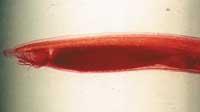Genetic heritage of Amphious
Amphious is a marine worm a few centimeters high. Despite being an invertebrate, it has some characteristics of vertebrates, so scientists consider it a transition animal. At the University of Washington they studied the genome of this being to explain how the separation between vertebrates and invertebrates occurred.

The key is the AmphiEomes/Tbr1 gene that appears in the Amphious genome. Regulates the development of the membrane called mesoderm in invertebrates. However, researchers have found that this gene also appears in vertebrates and that there are also two copies. The most surprising thing is that each copy has a different function. On the one hand, the gene called Eomesodermin has maintained its function of controlling the development of mesoderm. On the contrary, its copy, Tbrain1, has a new function: to regulate the development of the prosencephalon or the anterior brain.
Scientists claim it is an important discovery because it can explain how new animal characteristics appear throughout evolution.





